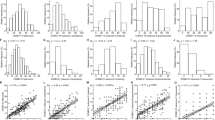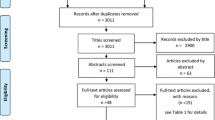Abstract
Otitis media with effusion (OME) is a common condition affecting children and a well-known cause of conductive hearing loss that can potentially lead to speech development disorders. Recent studies, however, have demonstrated the influence of OME on development of attention disorders or social adaptation and acceptance. Hence, this study aimed to investigate the behavioral trends of children with OME based on the Achenbach test. A group of 117 patients with episodes of OME at the age of 4–5 was compared with a control group according to the Achenbach system of evaluation, by application of the Child Behavior Checklist questionnaire (CBCL). Patients suffering from OME had more anxiety/depression related disorders and attention disorders as compared with the control group. The psychological effect of OME in children of ages 6–8 is evident with anxiety and depression disorders being especially prominent among these patients.
Similar content being viewed by others
References
Shekelle P, Takata G, Chan LS et al (2003) Diagnosis, natural history, and late effects of otitis media with effusion. Evidence Report/Technology Assessment No. 55. AHRQ Publication No. 03–E023. Agency for Healthcare Research and Quality, Rockville, MD
Tos M (1984) Epidemiology and natural history of secretory otitis. Am J Otol 5:459–462
Roberts JE, Rosenfeld RM, Zeisel SA (2004) Otitis media and speech and language: a meta-analysis of prospective studies. Pediatrics 113(3 Pt 1):e238–e248
McGee R et al (1982) Behavior problems and otitis media with effusion: a report from the Dunedin Multidisciplinary Child Development Study. NZ Med J 95:655–657
Timmerman A, Meesters C, Anteunis L, Chenault M (2007) Level of psychosocial adaptation in young school children with otitis media. Int J Pediatr Otorhinolaryngol 71:1843–1848
Reichman J, Healey WC (1983) Learning disabilities and conductive hearing loss involving otitis media. J Learn Disabil 16(5):272–278
Minter KR, Roberts JE, Hooper SR, Burchinal MR, Zeisel SA (2001) Early childhood otitis media in relation to children’s attention-related behavior in the first six years of life. Pediatrics 107:1037–1042
Hindley P (2006) Psychiatric aspects of hearing impairments. J Child Psychol Psychiatry 38:101–117
Hooper SR, Ashley TA, Roberts JE, Zeisel SA, Poe MD (2006) The relationship of otitis media in early childhood to attention dimensions during the early elementary school years. J Dev Behav Pediatr 27(4):281–289
Lee J, Witsell DL, Dolor RJ, Stinnett S, Hannley M (2006) Quality of life of patients with otitis media and caregivers: a multicenter study. Laryngoscope 116(10):1798–1804
Maes B, Grietens H (2004) Parent-reported problem behavior among children with sensory disabilities attending elementary regular schools. J Dev Phys Disabil 16:361–375
Roberts JE, Burchinal MR, Zeisel SA (2002) Otitis media in early childhood in relation to children’s school-age language and academic skills. Pediatrics 110(4):696–706
Ivanova MY, Achenbach TM, Rescorla LA et al (2007) The generalizability of the Youth Self-Report syndrome structure in 23 societies. J Consult Clin Psychol 75(5):729–738
Achenbach TM (1991) Child Behavior Checklist/4-18. University of Vermont, Department of Psychiatry, Burlington, VT
Achenbach TM, Becker A, Dopfner M, Heiervang E, Roessner V, Steinhausen HC, Rothenberger A (2008) Multicultural assessment of child and adolescent psychopathology with ASEBA and SDQ instruments: research findings, applications, and future directions. Child Psychol Psychiatry 49(3):251–275
Dekker MC, Koot HM, van der Ende J, Verhulst FC (2002) Emotional and behavioral problems in children and adolescents with and without intellectual disability. J Child Psychol Psychiatry 43:1087–1098
Biederman J, Monuteaux MC, Greene RW, Braaten E, Doyle AE, Faraone SV (2001) Long-term stability of the Child Behavior Checklist in a clinical sample of youth with attention deficit hyperactivity disorder. J Clin Child Psychol 30:492–502
Stenton JS (2007) Do middle ear infections matter? Student self-reported perceptions of behaviour, including social skills, following experience with otitis media with effusion. Int J Pedagog Learn 3(3):114–122
Bennett KE, Haggard MP, Silva PA, Stewart IA (2001) Behavior and developmental effects of otitis media with effusion into the teens. Arch Dis Child 85(2):91–95
Bellussi L, Mandalà M, Passàli FM, Passàli GC, Lauriello M, Passali D (2005) Quality of life and psycho-social development in children with otitis media with effusion. Acta Otorhinolaryngol Ital 25(6):359–364
Lous J, Burton MJ, Felding JU, Ovesen T, Rovers MM, Williamson I (2005) Grommets (ventilation tubes) for hearing loss associated with otitis media with effusion in children. Cochrane Database Syst Rev 25(1):CD001801
Robb PJ (2005) Adenoidectomy: does it work? J Laryngol Otol 121(3):209–214
Schraff SA (2005) Contemporary indications for ventilation tube placement. Curr Opin Otolaryngol Head Neck Surg 16(5):406–411
Paradise JL, Dollaghan CA, Campbell TF, Feldman HM, Bernard BS, Colborn DK, Rockette HE, Janosky JE, Pitcairn DL, Kurs-Lasky M, Sabo DL, Smith CG (2003) Otitis media and tympanostomy tube insertion during the first three years of life: developmental outcomes at the age of four years. Pediatrics 112(2):265–277
Paradise JL, Dollaghan CA, Campbell TF, Feldman HM, Bernard BS, Colborn DK, Rockette HE, Janosky JE, Pitcairn DL, Kurs-Lasky M, Sabo DL, Smith CG (2005) Developmental outcomes after early or delayed insertion of tympanostomy tubes. N Engl J Med 353(6):576–586
Paradise JL, Feldman HM, Campbell TF, Dollaghan CA, Rockette HE, Pitcairn DL, Smith CG, Colborn DK, Bernard BS, Kurs-Lasky M, Janosky JE, Sabo DL, O’Connor RE, Pelham WE Jr (2007) Tympanostomy tubes and developmental outcomes at 9 to 11 years of age. N Engl J Med 356(3):248–261
Author information
Authors and Affiliations
Corresponding author
Rights and permissions
About this article
Cite this article
Gouma, P., Mallis, A., Daniilidis, V. et al. Behavioral trends in young children with conductive hearing loss: a case–control study. Eur Arch Otorhinolaryngol 268, 63–66 (2011). https://doi.org/10.1007/s00405-010-1346-4
Received:
Accepted:
Published:
Issue Date:
DOI: https://doi.org/10.1007/s00405-010-1346-4




